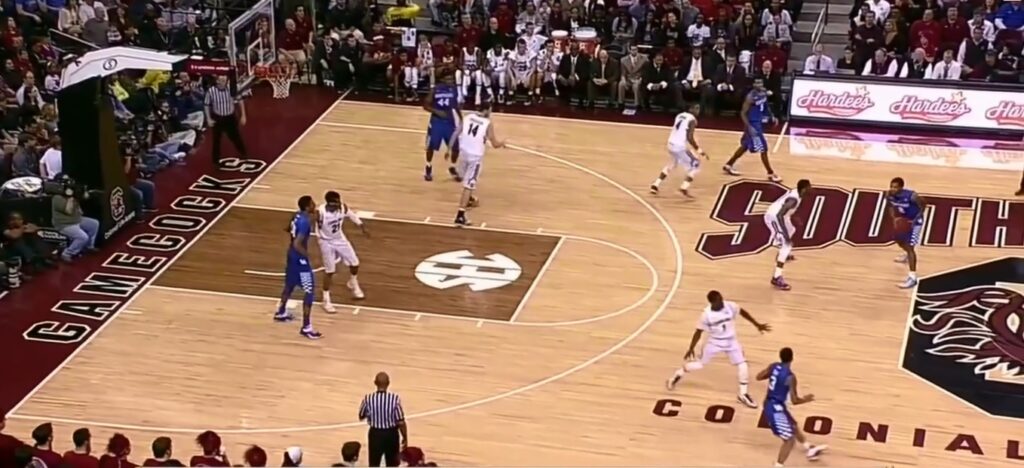The classical man-to-man defense is far and away the most common in today’s basketball.
This is particularly true as players advance to a higher competition level. In fact, due to professional players’ excellent outside shooting, each NBA team almost solely employs man-to-man defense.
The man-to-man defense involves all five defensive players on the court being assigned one opposing player to defend whenever they are on defense.
Strengths
- Every player must gain knowledge of man-to-man defensive principles – All youth players must develop good man-to-man habits as well as fully comprehend man-to-man defensive principles.
- Many Variations – Obviously it depends on the team you’re playing against and your team’s strengths and weaknesses, there are numerous methods for running your man-to-man defense.
- Future basketball preparation – The better players get at man-to-man defense in their youth, the more opportunities they’ll have as they progress to higher levels of play.
Weaknesses
- There is a lot to learn – Players will be required to grasp more defensive skills than they would if they played Pack Line defense or even a zone defense. A player must recognize how to defend and where they should position themselves in a variety of situations.
- It will take time for your players to run successfully – One of the most frequent reasons for youth coaches to use a zone defense is a lack of time to teach a man-to-man defense. They are correct. There is much to learn, and it will take some time. But it is well worth it.
- Inability to hide weak players – In man-to-man defense, everybody is held accountable for their role in defending the basketball as well as being able to help as well as rotate when necessary.
Man-to-Man Defense Rules

While I’ve heard coaches list hundreds of rules associated with man-to-man defense, there are only five that you should teach your players.
There is no middle penetration.
If you intend to teach your team how to play man-to-man defense, the following sentence is critical…
The most basic rule of man-to-man defense is to not allow the opponent to enter the middle of the line of traffic from the top of the wings.
Defensive players must instead use their stance as well as position themselves so that the opposition only can dribble down the sideline as well as the baseline.
When an opponent has the ball at the top of the key, we instruct them to the sideline.
We direct opposing players to the baseline when they have the ball on the wing.
“Why the baseline rather than the middle?”
We direct opponents to the sideline and baseline because they are much easier to defend as well as rotate on than when a player drives into the center of the lane.
This is because the roles and responsibilities of the help defenders are clear in terms of who is supposed to help and rotate whenever the basketball is on the wings or at the corners.
When the basketball is pushed into the middle, it is difficult to determine who is supposed to help and who is supposed to stay on their player, which frequently leads to open scoring chances for the opposition.
There are no ball reversals.
How many times have you got to hear a coach yell to his or her players, “Reverse the basketball!”?
I’m guessing a lot. Maybe you’ve done it yourself.
If you have, there is a valid reason for it… It benefits the offensive team!
The more you can get the defensive team moving and rotate, the more gaps in the defense will open up and the number of open scoring chances will increase.
So, when playing man-to-man defense, we never want the basketball to reverse back to the top or even the opposite side after it has been managed to pass to one side of the floor.
No Assistance from Defenders One-Pass Access

This is the most significant distinction between the Pack Line defense as well as the man-to-man defense.
In the Pack Line defense (which I frequently recommend), players one pass away from the basketball aid in driving lanes by preventing dribble penetration. The basketball can now be passed all around the perimeter.
Because the players one pass away from the basketball have been denying the pass to their player in man-to-man defense, driving lanes open up and the on-ball defender is more responsible for preventing the player with the basketball from entering the lane. If an opponent attempts to drive across the middle, the player one pass away can quickly stunt in their direction, causing the offensive player to start picking up the dribble, but they can never fully assist.
No Facial Hair
A defensive player must never let their opponent cut across their face in front of the basketball.
The ‘no face cuts’ rule is most commonly applied when the offense executes a ‘pass-and-cut.’
When an offensive player helps make a pass to a teammate (which will still happen even if we deny it), the defender must immediately ‘jump to the basketball’ to push their opponent to cut behind them rather than in front of them.
This rule is also essential when playing off-ball defense to prevent players from lighting up to the ball in order to receive a pass.
Simply put, when playing off-ball defense, a defender should always stay between their man as well as the basketball.
Move When the Ball Is Moving
The final rule is that players must play proper off-ball defense.
Each defensive player on the court must adjust their positioning on the court whenever the basketball moves.
Players will be taught that they need to stay alert at all times as well as anticipate passes that they might be able to deflect if they keep this in mind.
The bottom line
The man-to-man defense has been one of the top defenses you can run with your team, regardless of the level.
Because well almost all high-level basketball teams use this defense, the skills learned in man-to-man defense are critical for all players to develop from the start.

